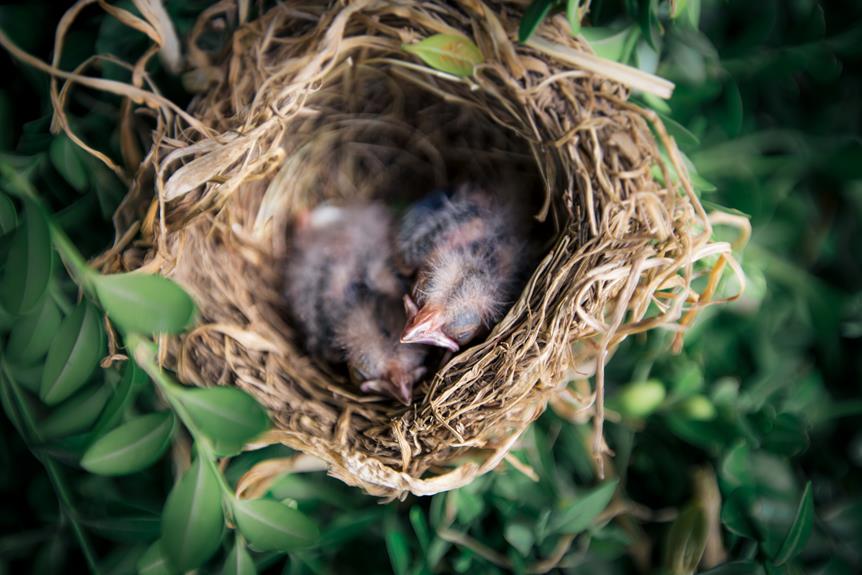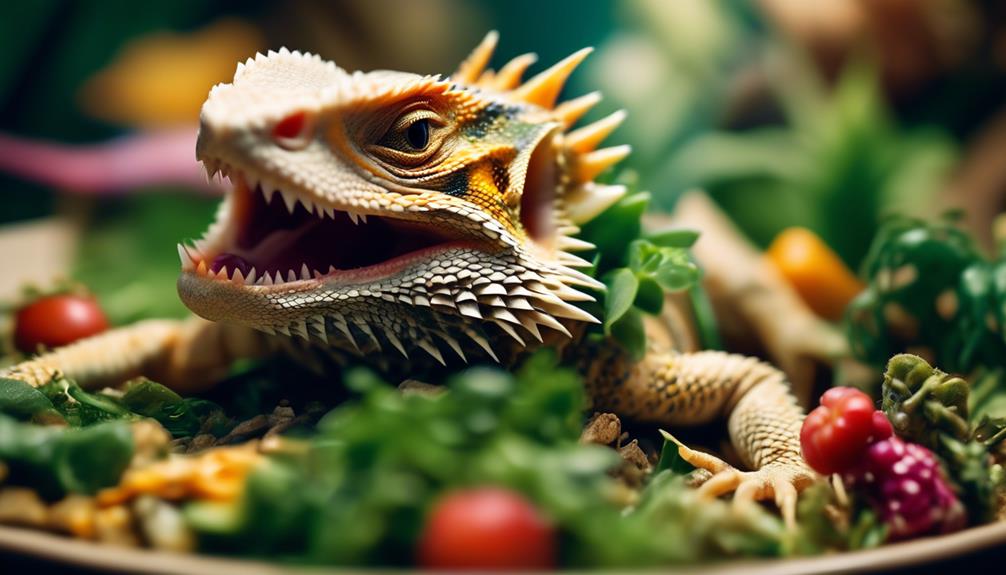Did you know that raising green iguana hatchlings can be both challenging and rewarding? With the right knowledge and care, you can create a thriving environment for these fascinating creatures.
In this article, we will explore the necessary steps to ensure your hatchlings' well-being. From selecting the perfect enclosure to addressing common health issues, we'll provide you with the expert guidance to guide you on this exciting journey.
Get ready to embark on an adventure in raising green iguana hatchlings!
Key Takeaways
- Green iguana hatchlings require specific care and attention to meet their needs and requirements.
- Proper temperature and humidity levels are crucial for the health and well-being of green iguana hatchlings.
- A varied and balanced diet consisting of leafy greens, vegetables, and limited fruits is essential for their nutrition.
- Gentle handling, socialization, and regular veterinary care are important for the overall health and happiness of green iguana hatchlings.
Selecting the Right Enclosure
When selecting the right enclosure for your green iguana hatchlings, you should consider their specific needs and requirements. Choosing appropriate substrate and ensuring proper lighting are crucial factors to consider.
For substrate, it's recommended to use materials such as reptile carpet, newspaper, or non-toxic sand. Avoid using gravel or wood chips as they can cause digestion problems if ingested.
Good lighting is essential for the health and well-being of your hatchlings. Provide a UVB light source, as it helps them metabolize calcium and prevents metabolic bone disease. A basking light is also necessary to create a warm area within the enclosure.
The temperature should range between 85-95°F (29-35°C) during the day and drop to around 75-80°F (24-27°C) at night.
Establishing the Ideal Temperature and Humidity Levels
To ensure optimal growth and health for your green iguana hatchlings, you need to set up and maintain the ideal temperature and humidity levels in their enclosure.
Green iguanas are ectothermic reptiles, meaning they rely on external sources of heat to regulate their body temperature. The recommended temperature range for hatchlings is between 85°F and 90°F during the day, with a slight drop to around 75°F at night. It's important to manage temperature fluctuations by using a thermostat-controlled heat source to prevent overheating or chilling.
Additionally, maintaining humidity levels between 60% and 80% is crucial for preventing dehydration and promoting proper shedding. This can be achieved by misting the enclosure with water regularly and providing a shallow water dish for your hatchlings to soak in.
Monitoring and adjusting these factors will help ensure the well-being of your green iguana hatchlings.
Providing a Nutritious and Balanced Diet
As you care for your green iguana hatchlings, it's important that you provide a nutritious and balanced diet to support their growth and overall well-being.
Green iguanas are herbivores, and their feeding habits consist of consuming a variety of leafy greens, vegetables, and fruits. Offer a mix of dark, leafy greens such as collard greens, mustard greens, and kale, as these provide essential nutrients like calcium and Vitamin A. Vegetables like carrots, bell peppers, and squash can also be included for added variety and nutrients. Fruits should be given sparingly due to their high sugar content.
To ensure your hatchlings receive all the necessary nutrients, consider using nutritional supplements specifically formulated for reptiles. These supplements can provide additional vitamins and minerals that may be lacking in their diet.
By offering a well-balanced diet and incorporating nutritional supplements, you can help your green iguana hatchlings thrive and stay healthy.
Now, let's move on to the next section about handling and socializing hatchlings.
Handling and Socializing Hatchlings
When handling and socializing your green iguana hatchlings, it's important to establish trust and bond with them through gentle and consistent interactions. Bonding techniques play a crucial role in developing a strong relationship with your hatchlings.
Here are some appropriate handling techniques to consider:
- Approach your hatchlings slowly and calmly, using a soft and confident touch.
- Support their body properly by placing one hand under their belly and the other supporting their back.
- Avoid sudden movements or loud noises, as they can startle the hatchlings and hinder the bonding process.
- Spend regular time with them, allowing them to explore your presence and gradually get used to your touch.
Addressing Common Health Issues
Take note of three common health issues that green iguana hatchlings may face, and learn how to address them effectively. Green iguana hatchlings are susceptible to respiratory infections, which can occur due to poor environmental conditions such as low humidity or improper temperature gradients. To prevent respiratory infections, ensure that the enclosure is properly ventilated and maintain appropriate humidity levels. Another common health issue is parasites, including internal parasites like roundworms and external parasites like mites. Regular fecal examinations and deworming treatments can help in dealing with internal parasites. To address external parasites, thoroughly clean the enclosure and treat the iguana with appropriate medications. By staying vigilant and addressing these health issues promptly, you can ensure the well-being and longevity of your green iguana hatchlings.
| Health Issue | Prevention and Treatment |
|---|---|
| Respiratory Infections | – Maintain proper humidity and temperature levels in the enclosure. |
| – Ensure proper ventilation in the enclosure. | |
| – Seek veterinary care if respiratory infection symptoms, such as wheezing or difficulty breathing, are observed. | |
| Parasites | – Conduct regular fecal examinations to detect internal parasites. |
| – Administer deworming treatments as recommended by a veterinarian. | |
| – Clean the enclosure regularly and treat the iguana with appropriate medications to address external parasites. |
Frequently Asked Questions
How Long Does It Take for Green Iguana Hatchlings to Reach Their Full Adult Size?
It typically takes green iguana hatchlings several years to reach their full adult size. The growth rate of these hatchlings can be influenced by various factors, such as diet, temperature, and habitat conditions.
Can Green Iguana Hatchlings Be Kept Together in the Same Enclosure?
Yes, you can keep green iguana hatchlings together in the same enclosure. However, it is important to ensure that the enclosure provides enough space and meets the temperature requirements for their optimal growth and development.
Are There Any Specific Plants That Should Be Avoided When Creating a Habitat for Green Iguana Hatchlings?
To provide a safe habitat for green iguana hatchlings, it is important to avoid toxic plants. Instead, choose suitable plants that are non-toxic and provide the necessary nutrition and enrichment for their growth and development.
What Are Some Common Signs of Stress in Green Iguana Hatchlings?
When raising green iguana hatchlings, it's important to recognize common signs of stress. Look out for decreased appetite, lethargy, and aggressive behavior. Address stress by creating a comfortable habitat and providing proper nutrition and socialization.
Can Green Iguana Hatchlings Be Trained to Use a Litter Box or Similar Area for Their Waste?
Yes, green iguana hatchlings can be trained to use a litter box or designated area for waste disposal. Various methods, such as positive reinforcement and consistency, can be effective in teaching them this behavior.
Conclusion
In conclusion, raising green iguana hatchlings presents both challenges and rewards. Selecting the right enclosure, maintaining optimal temperature and humidity levels, providing a nutritious diet, and handling hatchlings are all important aspects to consider.
Additionally, addressing common health issues is crucial for their well-being. Despite these challenges, the experience of raising these fascinating creatures can be highly rewarding.
By following scientific knowledge and being detail-oriented, you can create a thriving environment for your green iguana hatchlings.

